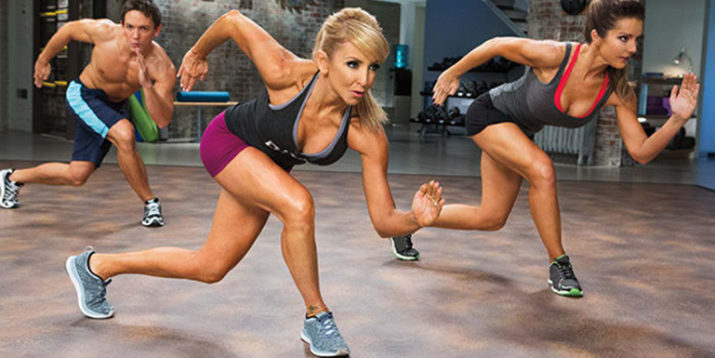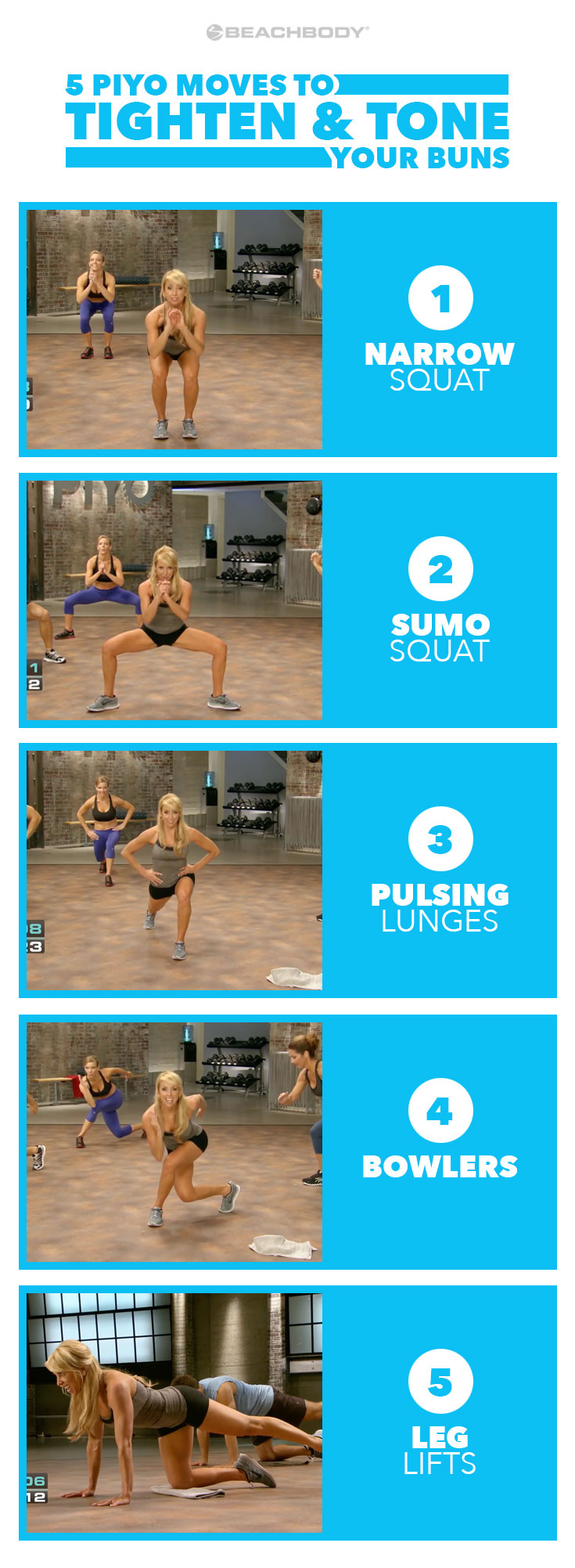5 PiYo Moves to Tighten and Tone Your Buns

If you’re looking to get a shapely booty, you’ll find the exercises in the PiYo Buns workouts will get you to your goal.
But there are more — dare we say better —benefits to having strong glutes than just looking good walking away.
What else?
Add reduced back pain, better posture, improved athletic performance, and greater total-body strength and power to the list.
What Is PiYo Buns?
PiYo Buns is a 30-minute-long lower body workout that’s part of the yoga and Pilates-inspired PiYo program created by Super Trainer Chalene Johnson.
The exercises in PiYo Buns include a wide variety of lunges and squats that will help tone your hamstrings, quadriceps, and glutes.
The Benefits of Strong Glutes
If you’re often guilty of skipping leg day… let’s dive deeper into why strong glutes are so important.
1. Strong glutes can help reduce back pain
When you think of your core, you’re probably think of your abs and possibly your obliques. But the glutes are part of it, too.
In fact, the muscles that make up the core include the rectus abdominus (the abs), the multifudus, the transverse abdominis, the internal and external obliques, the scapular stabilizers, the pelvic floor muscles, and the gluteus maximus, medius, and minimus.
The rectus abdominus and the obliques help support and stabilize the spine.
The glutes help stabilize and control the movement of the pelvis and thighs, as well as extend the hips (e.g., when you stand or run). (You extend your hips when you stand and flex them when you sit.)
When your glutes are weak—as they are for most people who sit all day — they underperform in the hip extension department.
The muscles primarily responsible for flexing the hips (i.e., the psoas), meanwhile, become overactive, causing them to shorten and tighten.
The combination of weak glutes and tight psoas causes the pelvis to tilt forward. This is known as anterior pelvic tilt and it increases the strain on the lumbar vertebrae.
The result: Back pain.
Strengthening your glutes — and the rest of your core — can help both reverse the situation, and prevent it from occurring in the future.
2. Strong glutes can boost athletic performance and help correct muscle imbalances
The glutes are also a key member of your “posterior chain” — a series of muscles running along the backside of your body that includes your erector spinae, glutes, hamstrings, and calves.
Just focusing on the muscles on the front (anterior) of your body — such as your chest, abs, and quads — can create imbalances that throw off your posture and alignment, increasing your risk of injury, as well as back and joint pain.
Getting your butt in gear can have the exact opposite effect, reducing not only muscle imbalances and injury.
Want to jump higher? Run faster? Improve your agility? Lift more weight? Then don’t skip leg day!
The gluteus maximus is the largest muscle in the body and help you pedal, lift weight, and push off the ground for a leap or your next step. Strengthening the gluteus maximus gives you more power for each of these motions.
5 Workout Moves for Strong Glutes
Below are five moves from PiYo Buns, the PiYo workout dedicated to toning your thighs and butt.
Do these five moves in the order shown, and repeat the sequence three times for a tighter, stronger butt.
Narrow Squat
How to do it: Stand with your arms at your sides and your feet parallel and 4 to 5 inches apart. Keeping your chest up, abs engaged, and weight on your heels, push your hips back and lower your body as far as you can.
As you squat down, bring your hands together in front of your chest. Return to the starting position, lowering your hands back to your sides. That’s one rep. Do 10.
Want an extra challenge? Pulse three times at the bottom of the squat, and only rise 3/4 of the way back up.
2. Sumo Squat
How to do it: Stand with your feet wider than your shoulders, and rotate your feet outwards slightly. Keeping your chest up, abs engaged, and weight on your heels, push your hips back, bend your knees, and lower your body as far as you can.
As you squat down, bring your hands together in front of your chest. Return to the starting position, lowering your hands back to your sides. That’s one rep. Do 10.
Want an extra challenge? Pulse three times at the bottom of the squat, and only rise 3/4 of the way back up.
3. Pulsing Lunges
How to do it: Stand tall with your feet hip-width apart and your hands on your hips. Keeping your chest up and abs engaged, step back with your left leg, lowering your body until your front thigh is parallel to the ground.
Pulse three times, never letting your rear knee touch the floor. Return to the starting position and repeat, this time stepping back with your right leg.
Continue alternating legs. Do 10 reps per leg.
4. Bowlers
How to do it: Stand tall with your feet hip-width apart and your hands by your sides. Keeping your chest up and abs engaged, step back with your left foot, crossing it behind your right leg as you swing your left arm up and your right arm back.
Lower your body until your right thigh is parallel to the floor. Pulse three times, and then return to a standing position, tapping the floor with the toes of your left foot briefly before dropping down into your next rep.
Do 10 reps, and then repeat on your other side.
5. Leg Lifts
How to do it: Get on your hands and knees with your hands directly below your shoulders and your knees directly below your hips.
Keeping your back flat and your abs engaged, lift your left leg and extend it straight behind you (it should be as close to parallel to the floor as possible).
Now move it left, bringing it as close to perpendicular to your body as possible. Move it back behind you, and then bend your knee, bringing it back below your hip (but don’t let it touch the floor).
That’s one rep. Do 10, and then repeat on your other side.

